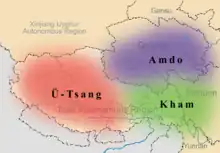Tibetan Empire
former empire (618–842) centered on the Tibetan Plateau
The old Tibetan Empire had three provinces — Ü-Tsang, Amdo and Kham. The names are still sometimes used, the three regions still have different dialects, and the Dalai Lama's Tibetan government-in-exile in Dharamsala still claims all three as parts of Tibet. To a traveller, though, that claim is completely irrelevant; all three former provinces are firmly under Chinese control; see Imperial China and Chinese Revolutions for historic background.

What is relevant for travellers is that access to China's Tibetan Autonomous Region is strictly controlled — foreigners need a permit to set foot there, and other restrictions may apply; see Tibet — but other parts of the former empire can be visited without those hassles, and some are still ethnically and culturally Tibetan. See Destinations below.
Tibet has only intermittently been fully independent since it was conquered by the Mongol Empire around 1250, though various rulers of China — Mongol, Ming, Qing, Nationalist, and Communist — have allowed autonomy in some areas. Large parts of the former empire have not actually been ruled by Tibet since the Qing Dynasty (Manchu rulers of China 1644-1912) expanded its borders into the area in the early 1700s.
